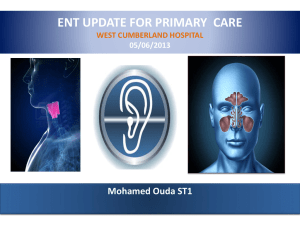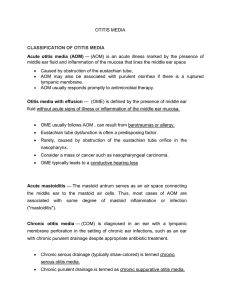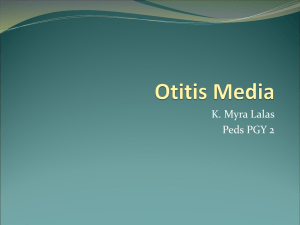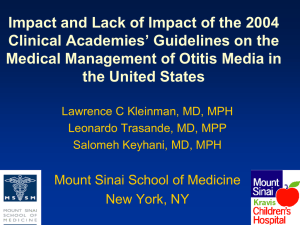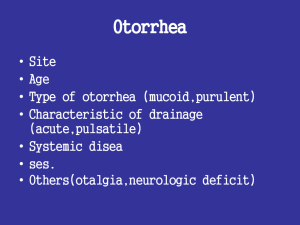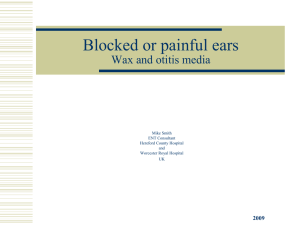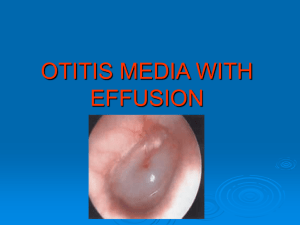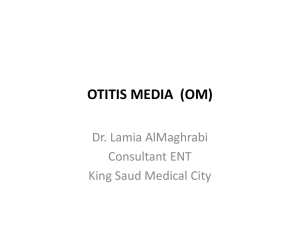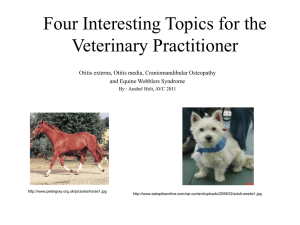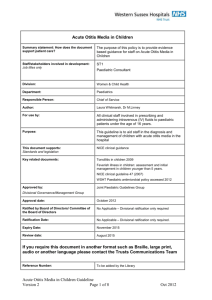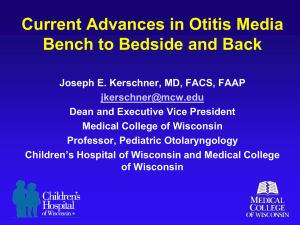Otitis media - College of Paediatricians
advertisement
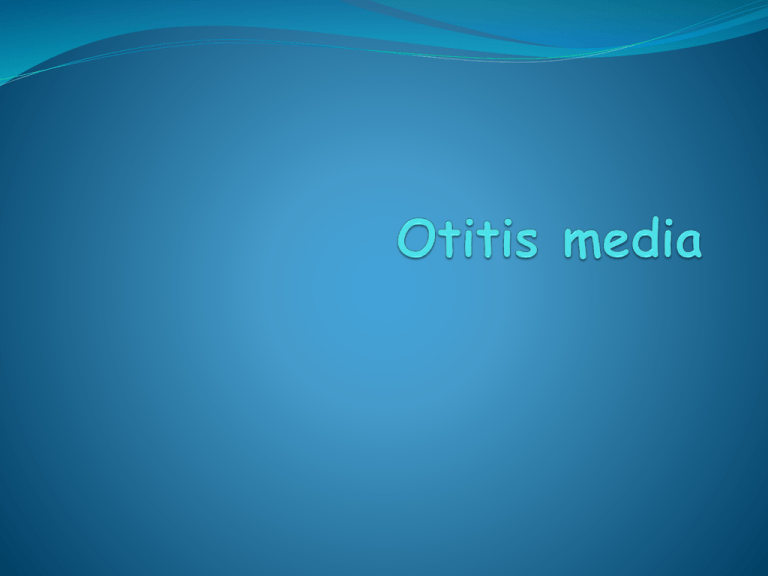
2 ½ year old girl Generally well. Attends nursery school Recent course of Augmentin (2 weeks prior) Mon 13 September 2010 – bilateral conjunctivitis; no fever, otherwise well; mild discharge; no preauricular lymph nodes After 3 days gave Tobrex eye drops Weekend – developed fever (not >38,5ºC), loss of appetite, bad temper, rhinitis, cough (croupy), grade 1 stridor Prelone syrup, saline spray, suctioning, Paracetamol, Nurofen Within 48-72 hours fever settled, rest of symptoms unchanged Tympanic membranes looked dull bilaterally, tonsils enlarged but no follicles Loss of appetite, more irritable than usual, restless at night (relieved by clearing nose). No otalgia reported Sent to school Wednesday 22 September (9 days after initial symptoms) teacher called – felt hot, sleepy, miserable, coughing Afebrile, chest clear, no distress Ears right – full TM, yellow (purulent) effusion, no erythema left – poorly visualised (wax), TM looked red ?tender when examined Throat – tonsils large Assessment: Otitis media. Effusion, but no fever, right ear not red. Assumed viral Treatment: intranasal steroids, continued saline to nose, analgesia Uneventful night Noticed crusted discharge in right ear next morning. TM perforated, no fresh exudate. Left ear unchanged Continued steroids, sent to school ?antibiotics necessary, however since clinically improved, delayed. Paediatrician advised antibiotics, but also happy to watch and wait for 48 hours. Improved. No fever, sleeping better, appetite returned, no further discharge, still no pain reported. Right TM perforated now sealed. Looks dull but no pus behind TM. Left TM slowly improving Still coughing, but improving Left wondering about accuracy of diagnosis ?viral/ bacterial Acute otitis media/ otitis media with effusion Was the other TM going to rupture? Uncertain about antibiotics Was withholding treatment appropriate? Why discuss Otitis media? Extremely common disease of childhood General practitioners, POPD doctors, private paediatricians see otitis media on daily basis Wards see complications of otitis media little attention paid to ears otherwise – tend to focus on ‘more serious’ conditions many HIV infected patients with chronic ear discharge Many doctors are also parents, may treat their own children Diagnostic difficulties Many diagnoses of otitis media incorrect Probably overdiagnosed, unnecessary antibiotics prescribed Possibly often missed also Management controversial Antibiotics vs watchful waiting Which antibiotics? Role of surgery Training deficient Covered briefly in ENT block Few (if any) bedside tutorials on the topic, rarely discussed on ward rounds Objectives Prevalence of OM Classify OM Pathogenesis Diagnosis and its difficulties Management guidelines and its controversies Prevention What is Otitis media? Generic term: inflammation of middle ear Variants, according to Aetiology Duration Symptomatology Physical findings Acute otitis media (AOM) Viral/ bacterial infection of middle ear Must fulfil 3 criteria: Rapid onset of signs and symptoms Signs and symptoms of middle ear infection/ inflammation Presence of middle ear effusion (MEE) Recurrent acute otitis media (RAOM) Otitis media with effusion (OME) Previously ‘suppurative/ secretory’ OM ‘Glue ear’ if persists for >6 weeks MEE of any duration, lacks associated signs and symptoms of infection Chronic suppurative otitis media (CSOM) Chronic inflammation of middle ear Persists > 6 weeks Associated otorrhoea through perforated TM/ tympanostomy tube/ surgical myringotomy Otitis media with effusion Chronic suppurative otitis media with perforated tympanic membrane Acute otitis media Prevalence 2nd most common disease of childhood Most common reason for antibiotics in childhood Prevalence rate 20% within first 2 years of life >80% children have had episode of AOM by age 3 Recurrent episodes common Most common between ages of 6 – 24 months 2nd peak at 4-5 years (school attendance) No gender predominance Equally common in black and white children Significance Significant costs Treatment Time lost from school and work Impact on overall use of antibiotics, development of drug resistance Developing countries extremely common major contributor to childhood mortality due to late presentation of intracranial complications Significant morbidity due to chronic perforated TM Functions of Eustachian Tube Equilibration of pressure Drainage of secretions Protection of middle ear Pathophysiology 2 theories Eustachian tube (ET) dysfunction Congestion, swelling of nasal mucosa, nasopharynx, ET due to URTI/ allergies Shorter, narrower ET in children more prone to blockage Obstruction => absorption of nitrogen, oxygen into surrounding capillaries => negative pressure => fluid ‘pulled’ into ET Fluid also accumulates due to exudate associated with viral infection Essentially sterile effusion Stasis => ideal environment for proliferation of bacteria Secondary bacterial/ viral infection => suppuration => features of AOM Not thought to be entirely accurate as same pathogenic bacteria in OME and AOM Newer theory Primary event = inflammation of middle ear mucosa in response to bacteria in middle ear Reflux up ET plays role Children prone to OM have radiographic evidence of reflux Documented presence of Pepsin in middle ear space in 60% of children with OME [may also occur in otherwise healthy children] Inflammatory mediators released due to bacterial antigens => increased mucin production => bacterial proliferation Whether cause or effect, Eustachian Tube Dysfunction universal in patients with middle ear effusions Causative organisms Streptococcus pneumoniae – 25 -50% AOM cases Haemophilus influenzae – 15 -30% Moraxella catarrhalis – 3 -20% Alloiococcus otitidis – new, gram positive, most frequent organism in AOM Remember TB Microbiology may be changing since introduction of pneumococcal vaccine (Prevenar) – relative increase in H influenzae, decrease in S pneumoniae 50% of H influenzae isolates β-lactamase producers 100% of M catarrhalis isolates β-lactamase producers 15-50% S pneumoniae isolates not Penicillin sensitive Of these, 50% highly Penicillin resistant Viruses RSV, Coronavirus, Rhinovirus, PIV, Adenovirus, Enteroviruses found in respiratory secretions, middle ear fluid in 40-75% AOM cases 5 – 22% of cases, purely viral (no bacteria found in middle ear fluid) Could account for apparent antibiotic failure Predisposing factors Host factors Younger age – immunity, anatomy of ET Immunity – HIV, diabetes, congenital immune deficiencies Genetics – familial clustering; environment may also play a role Anatomic abnormalities – cleft palate, Down syndrome, Apert syndrome Physiologic dysfunction – ET mucosa, ciliary dysfunction. Cochlear implants, reflux Obesity Environmental factors Breastfeeding exclusively for first 3-6 months of life protective. Protective effect persists beyond this also Prop-feeding Passive smoking Daycare attendance – increased colonisation, increased URTI’s, antibiotic-resistant organisms Socioeconomic factors Lower status = higher risk. Associated with higher risk for environmental exposure Use health resources less frequently, therefore not diagnosed Diagnosis Symptoms on History Otalgia Young children may pull ear (not specific sign) Headache Otorrhoea Other URTI symptoms – rhinitis, cough Fever (usually <40°c) in 2/3 of cases Irritability – may be sole symptom in infant/ toddler Lethargy – implies sick child Vomiting, diarrhoea, anorexia, nausea Examination Otoscopy Studies show most practitioners perform otoscopy incorrectly otoscope good light source cooperative patient (and parent!) wax should be cleared if possible crying => red TM fever => red TM Trauma => red TM know what normal TM looks like Healthy tympanic membrane. TM pearly grey Translucent Unperforated Light reflex not useful Healthy tympanic membrane Findings TM oedematous (cloudy, dull) and erythematous Bulging TM (laterally) – normal landmarks obscured Frankly purulent effusion seen through TM Possibly blistering of TM Pneumatic otoscopy Standard examination technique 90% sensitive, 80% specific for diagnosis of AOM if done correctly Only 50% of practitioners use this Need direct visualisation Air seal against external auditory canal TM should respond briskly to positive and negative pressure Adjuntive screening devices – detect MEE Tympanometry (impedance audiometry). Measures changes in acoustic impedance of the TM/middle ear system with air pressure changes in the external auditory canal Acoustic reflectometry. Measures reflected sound from the TM Acute Otitis Media Acute otitis media with purulent effusion behind a bulging tympanic membrane. “Although every effort must be made to differentiate AOM from OME from a normal ear, it must be acknowledged that, using all available tools, uncertainty will remain in some cases Efforts to improve clinician education must be increased to improve diagnostic skills and thereby decrease the frequency of an uncertain diagnosis Instruction in the proper examination of the child’s ear should begin with the first paediatric rotation in medical school and continue throughout postgraduate training.” taken from the American Academy of Pediatrics Clinical Practice Guideline for the Diagnosis and Management of Acute Otitis Media Treatment of AOM Recently much debate as to necessity for antibacterial agents USA – routine Europe – treat symptoms and treat if no improvement Rising rates of antibacterial resistance worrying Broader spectrum drugs used, more costly Decision to treat vs wait based on age, severity of illness, diagnostic certainty Treat pain regardless Paracetamol, Ibuprofen Topical agents (additional benefit, brief, >5 years) Observation Delay antibiotics 4872hrs Symptom relief Parent – doctor contact NB Otherwise healthy 6-24 months + not severe illness + uncertain diagnosis > 24 months +not severe illness or uncertain diagnosis Immediate antibacterial therapy < 6 months 6-24 months + certain diagnosis or if severe illness >24 months +severe illness + certain diagnosis (non-severe = mild otalgia, fever <39°C) Rationale for observation High rate of spontaneous resolution irrespective of treatment Antibiotics may shorten illness duration by 1 day Likelihood of recovery without antibiotics depends on severity of illness at presentation Poorer outcomes in younger children Mastoiditis risk not increased when wait and watch approach used But follow-up is NB Antibiotics may mask signs and symptoms, delay diagnosis Need caregiver to watch child closely, recognise worsening of condition Contact doctor if child worsens Prompt access to medical care if worsens Be able to obtain antibiotics if no improvement Discuss options with parents Weigh (small) benefit of using antibiotics, shortening illness against potential side effects Which antibiotic to use? 1st line most patients– Amoxicillin (90mg/kg/day) Safe, narrow spectrum, low cost, tasty If severe illness and recommended in daycare attendees – Augmentin (90mg/kg/day Amoxil component) 75% AOM cases due to M catarrhalis resolve on treatment with Amoxil High dose Amoxil allows middle ear fluid levels of drug to exceed MIC of all pneumococci that have intermediate resistance to Penicillin, and many which are highly resistant Penicillin allergic patients If not Type 1 hypersensitivity => 2nd generation cephalosporin (Cefpodoxime, Cefuroxime) If Type 1 hypersensitivity => Azithromycin (5 days) or Clarithromycin Vomiting patients/ not taking orally Single dose Ceftriaxone Duration uncertain Severe disease, younger children – 10 days >6 years old, mild-moderate disease – 5-7 days Time to response 48-72 hours Fever should settle, clinical improvement May worsen in first 24 hours If no improvement after 72 hours Wrong diagnosis Inadequate therapy If observing – start antibiotics (Amoxil) If severe/ worsening on Amoxil – start Augmentin Alternatives as mentioned can be used At this point, if Ceftriaxone necessary, give for 3 days If fail to improve on Augmentin – give Ceftriaxone (3 days) If AOM persists Tympanocentesis – therapeutic and diagnostic If unavailable, try Clindamycin Tympanocentesis essential if no response Complications Intratemporal Hearing loss TM perforation (acute and chronic) CSOM Cholesteatoma Mastoiditis Labyrinthitis Facial paralysis Intracranial Meningitis Subdural empyema Brain abscess Extradural abscess Lateral sinus thrombosis Prevention Remove from daycare if possible Breastfeed for 6 months where feasible Avoid prop-feeding Avoid pacifiers beyond 6 months of age Avoid secondary smoke exposure Vaccines Influenza vaccine decreases AOM episodes during flu season (>2 year olds) Prevenar decreases colonisation with vaccine- serotype strains 6%decrease in incidence, fewer doctor visits, decreased antibiotic use Summary AOM very common childhood illness Diagnostic uncertainty common Must be differentiated from normal ear, equally common OME Avoid unnecessary antibiotic use Select patients can be observed initially as many cases resolve regardless of treatment Follow up is essential Use appropriate antibiotics, upscale if necessary Treat pain
